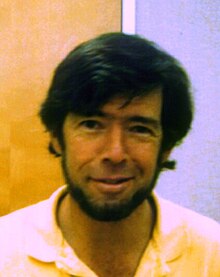Curtis Callan
Curtis Gove Callan (born October 11, 1942 in North Adams , Massachusetts ) is an American physicist and professor at Princeton University .
life and work
He received his Bachelor of Science degree from Haverford College in 1961 . He later studied at Princeton University with Sam Treiman and received his doctorate there in 1964 with the work Spherically Symmetric Cosmological Models . He stayed there as an instructor and went to Harvard University as an assistant professor in 1967 . In the same year he received a research grant from the Alfred P. Sloan Foundation ( Sloan Research Fellowship ). From 1969 to 1972 and from 1975 to 1977 he was at the Institute for Advanced Study . In 1972 he returned to Princeton as a professor, where he has been researching ever since. He has been the Higgins Professor of Physics at Princeton since 1986 and has been the James S. McDonnell Distinguished University Professor there since 1995. From 1998 to 2001 he was chairman of the physics faculty at Princeton and from 2005 to 2008 he was director of the Center for Theoretical Physics there. In 1971 and 1980 he was visiting professor at the University of Paris.
He researched, among other things, in the areas of gauge theory , string theory (including string theory on curved background-space times and application of string theory to explain the entropy of black holes ), monopoles and strong interaction (including in the 1970s on the role of instantons in the confinement mechanism of quantum chromodynamics with David Gross and Roger Dashen ). In the 1960s he dealt with soft pion theorems in K-meson decay and scaling laws for deep inelastic high-energy scattering . In 1970 he reformulated the theory of the renormalization group in particle physics with Kurt Symanzik . In the 1990s he was also involved in setting up an interdisciplinary research center for genome research at Princeton University.
Well-known PhD students of Callan are Juan Maldacena , Igor Klebanov and Peter Woit (* 1957).
In 2000 he received the Sakurai Prize , in 2004 he was awarded the Dirac Medal (ICTP) , and in 2016 he was awarded the Russian Pomeranchuk Prize . He is a Fellow of the American Physical Society (1974), a member of the National Academy of Sciences (1989) and the American Academy of Arts and Sciences (1987). In 2010 he was President of the American Physical Society.
Fonts
- Broken scale invariance in scalar field theory, Phys. Rev. D, Vol. 2, 1970, pp. 1541-1547
- with David Gross: Bjorken scaling in Quantum Field Theory, Phys. Rev. D, Volume 8, 1973, pp. 4383-4394
- with Sidney Coleman, Roman Jackiw: A new improved energy-momentum tensor, Annals of Physics, Volume 59, 1970, p. 42
- with Roger Dashen, David Gross: A theory of hadronic structure, Phys. Rev. D, Volume 19, 1979, pp. 1826-1855
- mit Dashen, Gross: Towards a theory of strong interactions, Phys. Rev. D, Vol. 17, 1978, pp. 2717-2763
- with Dashen, Gross: The structure of hadrons in QCD, Phys. Lett. B, Volume 78, 1978, pp. 307-312
- with Dashen, Gross: The structure of the gauge theory vacuum, Phys. Lett. B, Vol. 63, 1976, pp. 334-340
- mit Dashen, Gross: Instantons as a bridge between weak and strong coupling in QCD, Phys. Rev. D, Vol. 12, 1979, pp. 3279-3291
- Monopole catalysis of baryon decay, Nuclear Physics B, Volume 212, 1983, pp. 391-400
- with Edward Witten: Monopole catalysis of skyrmion decay, Nucl. Phys. B, Vol. 239, 1984, pp. 161-176
- with Sidney Coleman: The fate of the false vacuum II: the first quantum correction, Phys. Rev. D, Volume 16, 1977, pp. 1762-1768
literature
- Who's Who in America. 66th Edition, 2012, Volume 1: A – L. Marquis Who's Who, Berkeley Heights 2011, ISBN 978-0-8379-7031-8 (Volume 1), ISBN 978-0-8379-7035-6 (Complete Works ), ISSN 0083-9396 , p. 644
Web links
- Official site in Princeton. In: princeton.edu. (English).
- Sakurai Prize 2000. APS(English).
- Curtis G. Callan Biography. AIP(English).
Individual evidence
- ↑ Curtis Callan in the Mathematics Genealogy Project (English)
| personal data | |
|---|---|
| SURNAME | Callan, Curtis |
| ALTERNATIVE NAMES | Callan, Curtis Gove (full name) |
| BRIEF DESCRIPTION | American physicist |
| DATE OF BIRTH | October 11, 1942 |
| PLACE OF BIRTH | North Adams , Massachusetts |
